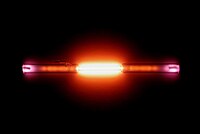
Photo from wikipedia
Helium and nitrogen variations in Panhandle–Hugoton field (PHF) gases are products of interaction between hydrocarbon gas from the Anadarko basin and at least two water masses with dissolved nitrogen and… Click to show full abstract
Helium and nitrogen variations in Panhandle–Hugoton field (PHF) gases are products of interaction between hydrocarbon gas from the Anadarko basin and at least two water masses with dissolved nitrogen and helium. The two most distinct water masses are from the Palo Duro basin (highest He/N2) and the Hugoton embayment (lowest He/N2). Geochemical data indicate several hundred million years of helium generation in porous rock. Helium migrated to the gas by diffusion through water-saturated rock and by west-to-east water flow. Sediment and basement helium generation and helium migration were modeled to validate timing and source of PHF helium. Models indicate a predominantly sedimentary helium source with some basement helium charge on the Amarillo uplift. Helium in the central and eastern PHF diffused from underlying rocks, whereas gases on the west and southwest sides were enriched in nitrogen and helium delivered by hydrodynamic water flow. Nitrogen in high-nitrogen gases was probably sourced as ammonium released from clays by cation exchange with brines derived from overlying salt units. The amount of mudrock (nitrogen and helium source) relative to other potential helium sources (arkose, radioactive dolomite) correlates to decreasing gas He/N2. The high helium concentrations in PHF gases result from multiple favorable circumstances. Old pore water accumulated dissolved helium during hundreds of millions of years of helium generation in sediment. High water/gas and low pressure favored higher helium concentrations in gas. Hydrodynamic flow delivered helium-rich pore water from basins west of the PHF.
Journal Title: AAPG Bulletin
Year Published: 2019
Link to full text (if available)
Share on Social Media: Sign Up to like & get
recommendations!